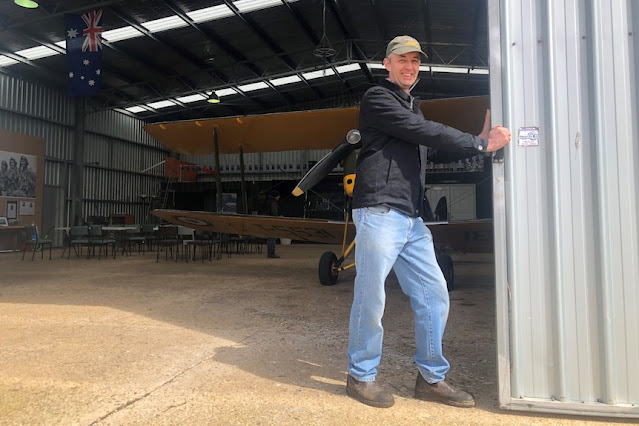It is hard to comprehend just how quick a World War II fighter plane is until it roars over you at just above tree-top level.
Tyabb's small aerodrome on Victoria's Mornington Peninsula is home to a Curtis P-40 Kittyhawk.
Powered by a Packard V12 engine with double the power of a modern Ferrari, it is capable of 550 kilometres per hour.
The 80-year-old plane is more than twice as fast as a garden-variety Cessna light aircraft.
In terms of performance and ability, it is outmatched by another Tyabb resident: a P-51 Mustang, a version of the thoroughbred fighter credited with winning the European air war.
In the town of Temora, 600 kilometres away in regional New South Wales, sits a pair of perhaps the most famous of all warbirds: the Supermarine Spitfire.
'It's a sense of history'
Mr Makowski said the fascination with World War II-era flying machines had diminished little over the 80 years since the conflict's end.
"It's a sense of history — being close to these aircraft, seeing them, hearing them, smelling the fuel burn and even touching them in some cases, it takes you back to a time," he said,
For those who pilot the warbirds, the connection runs deeper still.
Judy Pay owns and flies an ex-RAAF Mustang (technically an Australian-build CA-18 rather than a P-51) and a United States Army Air Corps P-40 Warhawk, both based at Tyabb.
Her personal "squadron" also includes a Vietnam-era T-28 Trojan, a Tiger Moth biplane, T-6
(Harvards), two Vampire jet fighters, several helicopters and a rare Fieseler Storch, among others.
Ms Pay grew up close enough to Tyabb to observe historic aircraft regularly.
When her own children went to school, she decided to take some flying lessons.
Overcoming airsickness, Ms Pay has now been flying for 46 years and owns and operates a historic aircraft restoration business.
She acknowledged the wonderful work done to restore and maintain historic aircraft in museums, but said it was difficult to appreciate their capability unless you saw them in flight.
"Unless you hear the [Rolls Royce] Merlin and see it in action, you have no appreciation at all of what it was and what it does, and how it basically saved Europe," Ms Pay explained.
"Unless you hear the [Rolls Royce] Merlin and see it in action, you have no appreciation at all of what it was and what it does, and how it basically saved Europe," Ms Pay explained.
Small airfield, big history
Tyabb Airfield was once a regional airport but has since been surrounded by Melbourne's ever-spreading suburbia.
The Cressy Aerodrome in Western Victoria, on the other hand, is two runways and several hangars surrounded by canola crops.
Cressy served as an RAAF training base during World War II before it was abandoned and largely forgotten.
The airfield is now owned by Paul Lamont.
"My father was here in World War II," Mr Lamont said.
"He told me all about the base where he trained, when I was growing up on the Murray. I always mucked around with him about buying it one day.
"I moved here in 2005 and bought the house that faced the airport.
"I wrote on a whiteboard I would buy it [the aerodrome]. That note sat there for 10 years. My wife thought I was crazy.
"When it came up for sale 10 years later, I said, 'Get prepared to go broke because we're going to get it'. One of the neighbours said he didn't like aeroplanes, so I bought him out as well."
When Mr Lamont took over the airfield, it was little more than an empty paddock.
"It was the empty canvas — we put up this 20 by 20 metre hangar. We refurbished both runways, with night lights on runway 0119, and windsocks.
"We have started having Anzac Day functions and Remembrance Day functions, and the crowds are just getting bigger."
Aircraft kept at the Victorian airfield during WWII included Hawker Demon biplanes, CAC (Commonwealth Aircraft Corporation) Wirraway trainers, Avro Anson and Bristol Beaufort light bombers, and Spitfires, among others, according to historian Dave McGinness.
Had the Japanese invaded Australia's north, Cressy's airfield was sufficiently large and well-equipped to become a medium bomber base.
Its lone "resident" warbird today is a Tiger Moth called Millie.
It was built in 1942 and served as a trainer, and is now a familiar sight at flyovers and air shows in the southern states.






Comments
Post a Comment